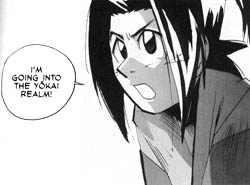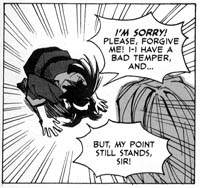 By Nina Matsumoto
By Nina Matsumoto
192 pages, black and white
Published by Del Rey
There are a lot of different terms being used for when a publisher known for their manga line decides to produce (instead of just translate) some comics of their own. American manga, amerimanga, western manga, world manga, global manga, neo-manga, original English-language manga (or OEL manga), the names appear almost as fast as the comics themselves. Sometimes the attempts are merely formatted the same but in no other ways different. Sometimes the comics ape many of the hallmarks of Japanese comics. And sometimes it has more to do with going for the same sort of undefinable feel that the creator gets when reading manga. With all of that in mind, Nina Matsumoto has one of Del Rey’s early attempts at adding Western-produced comics into their manga line, in the form of Yokaiden.
 Yokai are spirits, strange creatures that lurk in the shadows for the unwary. Most people in Hamachi’s village fear and even hunt the Yokai, but Hamachi desperately wants to see and meet them. When tragedy suddenly strikes, though, Yokai finds himself all alone and decides to travel into the world of the Yokai to seek answers and possibly revenge. But is he really ready for what is waiting in the Yokai’s own lands?
Yokai are spirits, strange creatures that lurk in the shadows for the unwary. Most people in Hamachi’s village fear and even hunt the Yokai, but Hamachi desperately wants to see and meet them. When tragedy suddenly strikes, though, Yokai finds himself all alone and decides to travel into the world of the Yokai to seek answers and possibly revenge. But is he really ready for what is waiting in the Yokai’s own lands?
Story wise, Yokaiden reminds me a lot of Mushishi, with its numerous species of creatures that are mostly hidden from the rest of the world but have strange abilities that are simultaneously entrancing and potentially deadly. Then again, a lot of Yokaiden will certainly feel familiar to long-time comic readers (manga or otherwise); the young orphaned boy who wants more than his little town, the mysterious land just around the corner, the gruff older master who warns our hero away from what is bound to be too big for him to handle all alone. Similarity alone isn’t necessarily a problem, though, if the comic is executed with a certain level of skill and energy. While Matsumoto seems on her way towards just that, at the same time I’m not entirely convinced that she’s there right now. Yokaiden Vol. 1 just feels very rushed and lacking in any strong transitions from one chapter to the next; it feels like a never-ending rush of new Yokai for Hamachi to meet and exclaim loudly about. It feels like Matsumoto is trying to throw everything onto the page as fast as possible in order to see what sticks; talking lanterns, wise samurai, angry predators, and a chase for a potentially murderous Yokai. For what is supposed to be a fantastical and amazing different land that Hamachi has journeyed to, it feels like any random landscape with a bunch of monsters walking on and waving hello. Matsumoto needs to slow down a little bit, set some sort of mood, let us feel like Hamachi is more than just a Yokai-fact-spouting-book on legs. The end of the first volume has a villager comment to the local warrior, “Slow down before you choke on your food.” I can’t help but feel that the same advice could be equally apply elsewhere; there’s so much being thrown at the reader that if Matsumoto isn’t careful, there will be more choking going on.
 Matsumoto’s art comes across in an average Japanese-influenced style; open facial expressions, large flowing hair, and a whole lot of speed lines. Her art reminds me a bit of art book sketches, with the thick, slightly rough ink strokes on the page. That’s not a bad thing, but it some times does give the impression of pages being dashed off. The end result is that it feels very young and raw; Matsumoto’s enthusiasm for Yokaiden is certainly best expressed in her art. This is a book that I wish was in color rather than black and white, though; the front and inside cover illustrations are stronger than the black and white interiors, probably because Matsumoto’s able to use those colors to add extra depth and texture to her art. I’m not saying that the black and white art is bad by any stretch of the imagination, but rather that I don’t think that medium plays as well to her strengths.
Matsumoto’s art comes across in an average Japanese-influenced style; open facial expressions, large flowing hair, and a whole lot of speed lines. Her art reminds me a bit of art book sketches, with the thick, slightly rough ink strokes on the page. That’s not a bad thing, but it some times does give the impression of pages being dashed off. The end result is that it feels very young and raw; Matsumoto’s enthusiasm for Yokaiden is certainly best expressed in her art. This is a book that I wish was in color rather than black and white, though; the front and inside cover illustrations are stronger than the black and white interiors, probably because Matsumoto’s able to use those colors to add extra depth and texture to her art. I’m not saying that the black and white art is bad by any stretch of the imagination, but rather that I don’t think that medium plays as well to her strengths.
The basic concept of Yokaiden Vol. 1 is sound, and there is a lot of potential just waiting to be unleashed here. Matsumoto clearly understands her creations very well in her head, but it doesn’t feel like all of that is getting onto the page just yet. There’s a section at the end which shows off the villagers in the town—up until that point I think it’s safe to say that most of them haven’t even appeared yet. It feels very strange and off-putting, like Matsumoto is putting her cart before the horse. I appreciate that she has so much that she wants to show, but she needs to slow down and let the reader soak it all in. Right now, she’s got a good target in sight, but hasn’t quite hit it. Hopefully, in time, she’ll be much closer to that mark.
Purchase Links: Amazon.com
